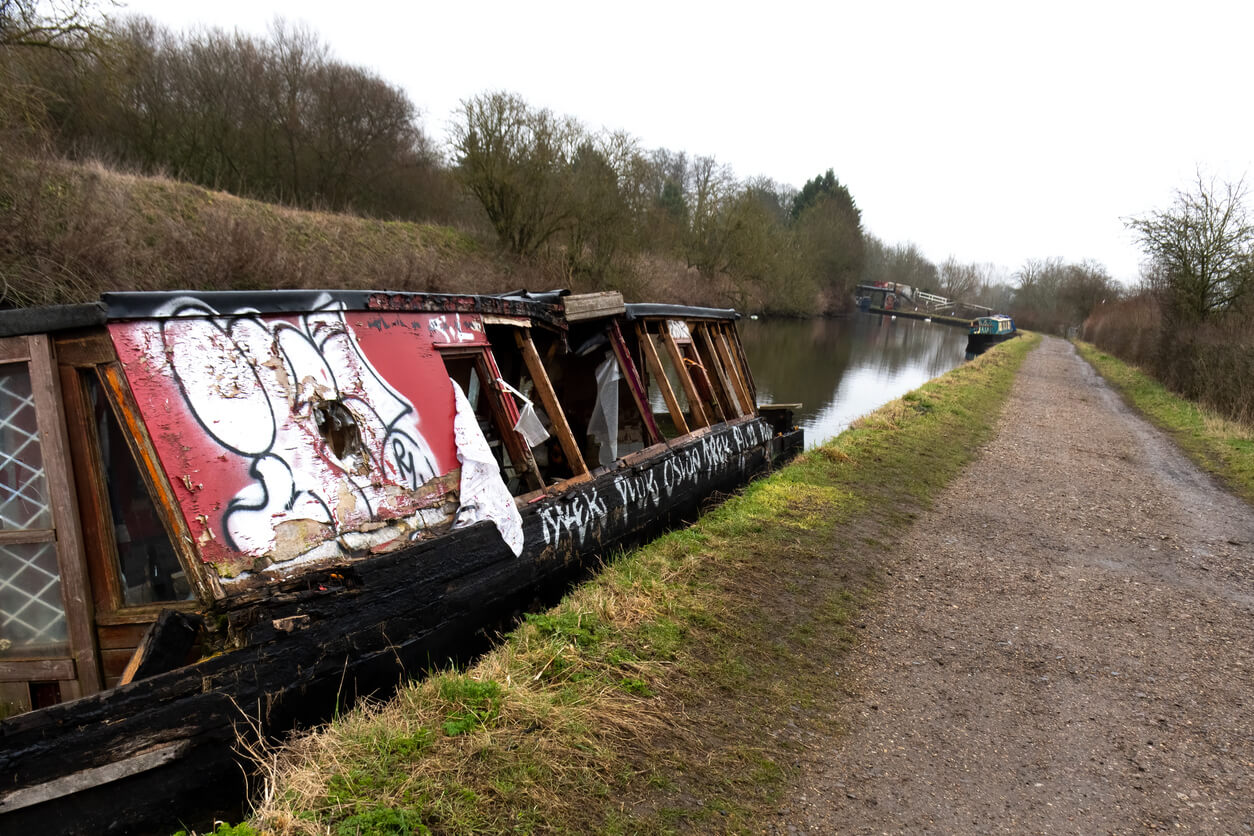Narrowboat crime: protecting against theft and vandalism
30 May 2025

Cruising along the canals or living aboard a narrowboat can be a wonderfully peaceful lifestyle. But just like with any home or vehicle, crime can occasionally happen. Whether it’s a break-in, vandalism, or even a stolen boat, being prepared can save you time, money and stress.
In this guide, we’ll look at what narrowboat crime involves, how common it is, where it tends to happen, and most importantly—how to protect your boat and peace of mind.
What is narrowboat crime?
Narrowboat crime means any illegal activity involving canal boats, including theft, vandalism, and break-ins. While uncommon, it can and does happen, especially if security is lacking.
The most common types of narrowboat crime include:
- Narrowboat theft—stealing your entire boat.
- Narrowboat vandalism—deliberate damage to your narrowboat, such as smashed windows, graffiti or ripped covers.
- Break-ins—thieves entering boats to steal valuables such as tech, tools, cash or solar panels.
- Theft of boat parts—items like batteries, generators, ropes and even gas bottles can be tempting to steal.
Why are narrowboats sometimes targeted?
- Boats can be moored in secluded spots, especially overnight.
- Many narrowboats are filled with valuable tech, equipment and tools.
- Some criminals believe boats are easier targets than houses or cars.
- Boats may be empty for days or weeks at a time.
How common is crime on narrowboats?
Crime against narrowboats isn’t hugely common, but it’s something to be aware of. According to the Canal & River Trust, most narrowboat thefts are rare and many stolen boats are later recovered. That said, theft from boats is more common, especially in cities or poorly lit areas.
In one case, a stolen narrowboat in Coventry was stripped of all valuables and sunk—drawing attention to the need for better security. Acts of narrowboat vandalism, such as smashed windows, graffiti or broken locks, tend to occur more frequently in cities or along busy towpaths.
Theft of the whole boat is unlikely, but protecting against theft of onboard possessions and vandalism is still important.
Related: A guide to narrowboat toilets
Where does narrowboat crime happen the most?
Crime can happen anywhere on the canal, but some areas are more at risk than others.
- Cities—cities like London, Birmingham and Manchester tend to have higher crime rates in general, which also applies to the canals.
- Secluded moorings—although peaceful, these spots can also be risky due to the lack of people and lighting.
- Public towpaths—easy public access to boats means more chances for opportunistic thieves.
- Temporary moorings—constantly changing locations can make it hard to assess how safe a mooring is.
When choosing where to moor:
- Look for well-lit areas near other boats or public activity.
- Avoid secluded spots when leaving the boat unattended.
- Speak to other boaters about any local narrowboat crime.
How to protect your narrowboat from crime
While you can’t guarantee total safety, there’s a lot you can do to make your narrowboat safe from thieves or vandals.
1. Install a security alarm system
- Use a marine-grade alarm designed specifically for boats.
- Pick models with motion sensors and door contacts.
- Choose systems that can alert your phone if the alarm is triggered.
2. Fit motion-sensor lights
- Bright lights can scare off intruders.
- Put lights above entry points like doors and hatches.
- Solar-powered lights are ideal for off-grid boaters.
Check out this handy guide on narrowboat solar panels for powering your security setup.
3. Secure your windows and doors
- Use locks on all doors and hatches.
- Check window fastenings or add security bars if needed.
- Consider polycarbonate windows for better protection against break-ins.
4. Don’t leave valuables on display
- Keep laptops, phones, tablets and wallets out of sight.
- Put tools, fishing gear, and electronics in onboard storage or remove them.
- Get hidden compartments for securing valuables.
5. Use a GPS Tracker
- GPS trackers can alert you if your boat is moved.
- Some trackers send real-time location updates to your phone.
- Trackers can increase the chance of recovering a stolen boat.
6. Disable the engine when unattended
- Remove the ignition key or install a battery isolator switch.
- Fit a hidden fuel shut-off valve or anti-theft engine lock.
- This makes your boat much harder to start and steal.
7. Get to know other boaters
- Building relationships with other boaters means more eyes on your boat.
- Fellow boaters often notice suspicious activity faster than strangers would.
- Many communities have WhatsApp groups to share local alerts or crime reports.
8. Keep curtains or blinds partly open to look like someone is on board.
- Use timers for lights or radios if you’re away.
- A boat that looks lived-in is far less likely to be targeted.
9. Visit regularly if you don’t live aboard
- Make regular visits if you use your boat for holidays.
- Ask a friend to check in if you’re away for long periods.
10. Consider narrowboat insurance
- No matter how careful you are, having insurance can reassure you.
- Look for policies that cover both narrowboat theft and narrowboat vandalism.
- Craftinsure arranges specialist narrowboat insurance that provides up to £5m third-party cover and protects your boat against loss or damage from fire or theft.
Reporting narrowboat crime
If you become a victim of crime, don’t hesitate to report it. It’s the best way to protect yourself and others.
- Call the police on 101 for non-emergencies or 999 if it’s happening right now.
- Report to the Canal & River Trust, especially if you’re on their waterways.
- Contact your insurance provider to begin the claims process—Craftinsure makes this quick and easy.
- Tell other boaters nearby. If they’re aware of the issue, they can keep an eye out or report similar incidents.
- Use social media or forums to share stolen items or boat sightings. The boating community is often the best way to recover lost or stolen property.
Remember to keep receipts, take photos of your belongings, and log serial numbers where possible. It all helps with your claim and recovery.
Final thoughts
While narrowboat crime shouldn’t stop you from enjoying life on the water, it’s something to take seriously. A few clever changes can make your boat much more secure and a lot less attractive to thieves.
To recap:
- Use alarms, lights and locks to secure your boat.
- Hide valuables and install a GPS tracker for extra safety.
- Get to know your boating neighbours—they’re your best support network.
- Consider investing in specialist narrowboat insurance.
Planning to buy a boat soon? Be sure to check out our helpful buying a narrowboat guide before you start your journey.
Specialist narrowboat insurance through Craftinsure
If you’re concerned about narrowboat crime, you may want to consider specialist insurance to protect your floating home against the risks of cruising on the canals.
Craftinsure arranges specialist narrowboat insurance that provides up to £5m third-party cover and protects your boat against loss or damage from fire or theft. Get an online quote in minutes.
Please note the information provided on this page should not be taken as advice and has been written as a matter of opinion. For more on insurance cover and policy wording, see our homepage.


